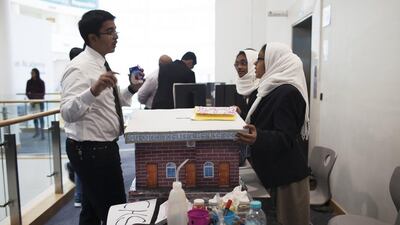DUBAI // Innovation was the buzzword as 600 schoolchildren from 30 schools across the country gathered on Saturday to offer ideas on how technology can help in tackling global challenges.
Pupils from grades 3 to 12 took part in the regional Gems Singularity University Global Innovation Challenge at Wellington Academy in Silicon Oasis, presenting 150 projects that they felt could make a difference.
“This is the sixth year we are running this event. It focuses on students using technology to address world challenges such as space, shelter, environment, food, energy and education,” said Christine Nasserghodsi, the Gems Education innovation leader.
“The 150 projects here were selected from 30 schools with American, British and Indian curricula, with each school choosing up to 15 projects.”
She said after looking at the judges scores and getting their feedback, the top-12 projects will be announced on February 9.
Grade 7 pupil Joe Anto Hilton said his project, My Little Garden, was a way to combine recycling with planting and growing organic food in apartments, houses and in offices.
The model he had on display was divided into four categories – my greenhouse, hydroponics, drip irrigation and my little garden.
“The greenhouse is where I can grow seeds and plants like mint and coriander. When you are in a bad mood you can sit inside and enjoy the fresh oxygen because these herbs are good for the body when you breathe them in,” the 12-year-old Indian said.
“Using plastic bottles to create the ceiling and walls of the greenhouse allowed sunlight in and was also a way to recycle. If I could create this for real, we could do it indoor at our homes to go green.”
Ameena Shafi and Hessa Chalukunnan, 11-year-old grade 6 pupils from India, came from Fujairah to show their project, Child Detector, which aids in ensuring that children are not left behind in various places.
“Our idea is basically about detecting children who are missed in schools, buses, parents’ cars and elevators,” said Ameena.
“For example, after all students leave school and security guards lock classrooms, if a child is kept inside a classroom the sensor will ring.
“A person in the control room will be alerted that there is a child in the room as the system will give a sign on the computer saying, ‘Child detected. Child to be saved’.”
Aspiring brain surgeon Atharv Naik came up with the idea of a neurological stimulator, which is designed to stimulate areas of the brain as a means to treat some brain disorders.
“I came up with the idea of making an artificial neural stimulation when I was watching a show about how brains define us, so I used the concept of using electricity to induce neurons,” said the 14-year-old grade 9 pupil from India.
“It can be used by normal people to increase neurons as well people with disorders and those who have depression or Alzheimer’s.
The Global Innovation Challenge was split into two categories – junior, for ages 13 and below, and senior for those 14 and older.
The top-12 senior projects receive funding and mentorship, with select projects presented at the annual Singularity Summit in California.
roueiti@thenational.ae

